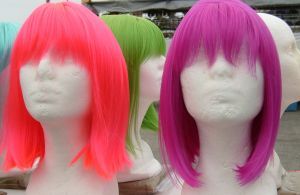It’s hard to imagine a world without hair color. Women would have to make friends with the shade they were born with, fewer blonds might roam on the planet and there’s no telling how many mature women might drive the scarf market to new heights. Hair color is certainly the easiest and most affordable transformational beauty product on today’s market; as a result of that little box of chemicals, faces are transformed, the aging process is mediated and the psychological benefits resulting from a treatment are endless. This bounty of benefits wouldn’t be possible without the expertise of scientists who knew a thing or two about the bucks and blessings hair color products produce and the advertisers who understand human nature. Next time you get into a discussion about hair color, drop a few facts on your audience so they know that beneath that gorgeous hair color shade resides a brain that’s just as beautiful.
History Lesson #1: With no Walgreen’s down the block, prehistoric women — followed by their more enlightened sisters in Roman, Greek and Egyptian societies — figured out ways to color their hair using the only materials available to them: plants, roots and minerals. Some experiments were successful. Others, not so much. From nutshells to roots, leaves and flowers – and with the addition of a few organic ingredients that are really too gross to mention – the search for hair color has deep literal and figurative roots.
History Lesson #2: When Lehigh University’s Pani Jadwiga Zajaczkowa researched Medieval- and Renaissance-era hair dyes, quirky data emerged from the fray. During these eras, women used walnut shells, tree bark, alum and apples to alter their hair color or piled leaves and roots atop their heads, tying them on with sinew and leaving the rotting vegetation on their scalps for the recommended two days. Women dyed their hair brown by applying a cooked mixture of lead, sulfur and quick time. To become a black-haired temptress during either era, women removed the heads and tails of green lizards and then cooked the body in oil to produce raven locks.
History Lesson #3: The Schuller connection. Hair historians trace the use of hydrogen peroxide for hair bleaching to around 1860, but it wasn’t until nearly 50 years later that commercial hair bleach debuted. French chemist Eugene Schuller invented his hair stripping formulation between 1907 and 1909 and its scientific name may be the precursor of unpronounceable ingredient names on hair dye boxes: paraphenylenediamine. Schuller wasn’t really searching for a commercial hair stripping solution; it was actually his pioneering work on the protein keratin that triggered the discovery of the base that launched today’s peroxide-based hair color science.
History Lesson #4: When advertising legend Shirley Polykoff got into the business in 1956, she was no stranger to the blessings of hair dye, so when her first writing assignment was working on a new client’s product launch — called Miss Clairol — it was a color match made in heaven. Shirley’s iconic slogans include, “Does she, or doesn’t she?” and “Only her hairdresser knows for sure,” tag lines appealing to a generation of women who talked about the benefits of living in the natural lane but weren’t above coloring their tresses. Polykoff is also the author of, “Is it true blonds have more fun?” and, in 1962, “If I’ve only one life to live, let me live it as a blond.
History Lesson #5: If the number of brands on retailer shelves can measure hair color product advances, hair dye history continues to be made. Brands like Nice ‘n Easy, Natural Instincts, Preference, Loving Care, Feria and Clairol regularly compete with new brands and formulas, but happily, some landmarks and catchphrases don’t disappear: “Because I’m worth it,” has remained L’Oreal’s evergreen theme ever since Ilon Specht wrote the tag line in 1973.





